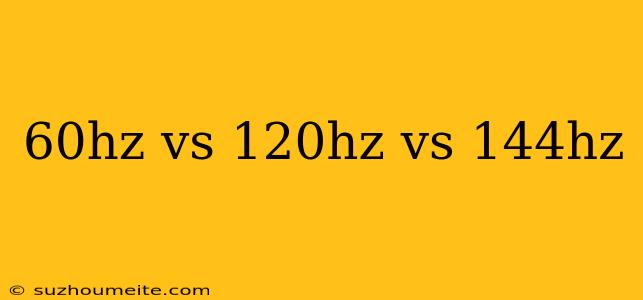60Hz vs 120Hz vs 144Hz: Which Refresh Rate is Best for You?
When it comes to choosing a monitor or TV, one of the key specifications to consider is the refresh rate. The refresh rate measures how many times the display updates the image per second, and it can have a significant impact on the overall viewing experience. In this article, we'll compare the three most common refresh rates: 60Hz, 120Hz, and 144Hz.
What is Refresh Rate?
Before we dive into the comparison, let's quickly explain what refresh rate is. Refresh rate is measured in Hertz (Hz) and it represents how many times the display updates the image per second. For example, a 60Hz display updates the image 60 times per second, while a 120Hz display updates it 120 times per second.
60Hz: The Standard Refresh Rate
Pros:
- Affordable: 60Hz monitors are generally cheaper than higher refresh rate monitors.
- Wide compatibility: Most computers and devices can handle 60Hz refresh rate.
Cons:
- Limited smoothness: 60Hz can cause screen tearing and motion blur, especially in fast-paced games and videos.
- Not ideal for gaming: 60Hz may not be sufficient for fast-paced games that require quick reflexes.
120Hz: The Mid-Range Refresh Rate
Pros:
- Smoother performance: 120Hz provides a noticeable improvement in smoothness and reduced screen tearing compared to 60Hz.
- Better for gaming: 120Hz is suitable for most modern games, providing a more responsive and immersive experience.
Cons:
- More expensive: 120Hz monitors are generally pricier than 60Hz monitors.
- Limited compatibility: Some devices may not support 120Hz refresh rate.
144Hz: The High-End Refresh Rate
Pros:
- Super smooth performance: 144Hz provides the smoothest and most responsive experience, ideal for fast-paced games and competitive gamers.
- Reduced motion blur: 144Hz reduces motion blur and screen tearing, making it perfect for fast-paced content.
Cons:
- Most expensive: 144Hz monitors are typically the most expensive option.
- High system requirements: 144Hz requires powerful hardware to run smoothly, which can be a limitation for some users.
Conclusion
Which refresh rate is best for you?
- If you're on a budget and don't require high-performance gaming, 60Hz is a good option.
- If you're a casual gamer or want a smoother experience, 120Hz is a good mid-range option.
- If you're a serious gamer or require the smoothest and most responsive experience, 144Hz is the way to go.
Remember, the refresh rate is just one factor to consider when choosing a monitor or TV. Other specifications like resolution, response time, and panel type also play a crucial role in the overall viewing experience.
